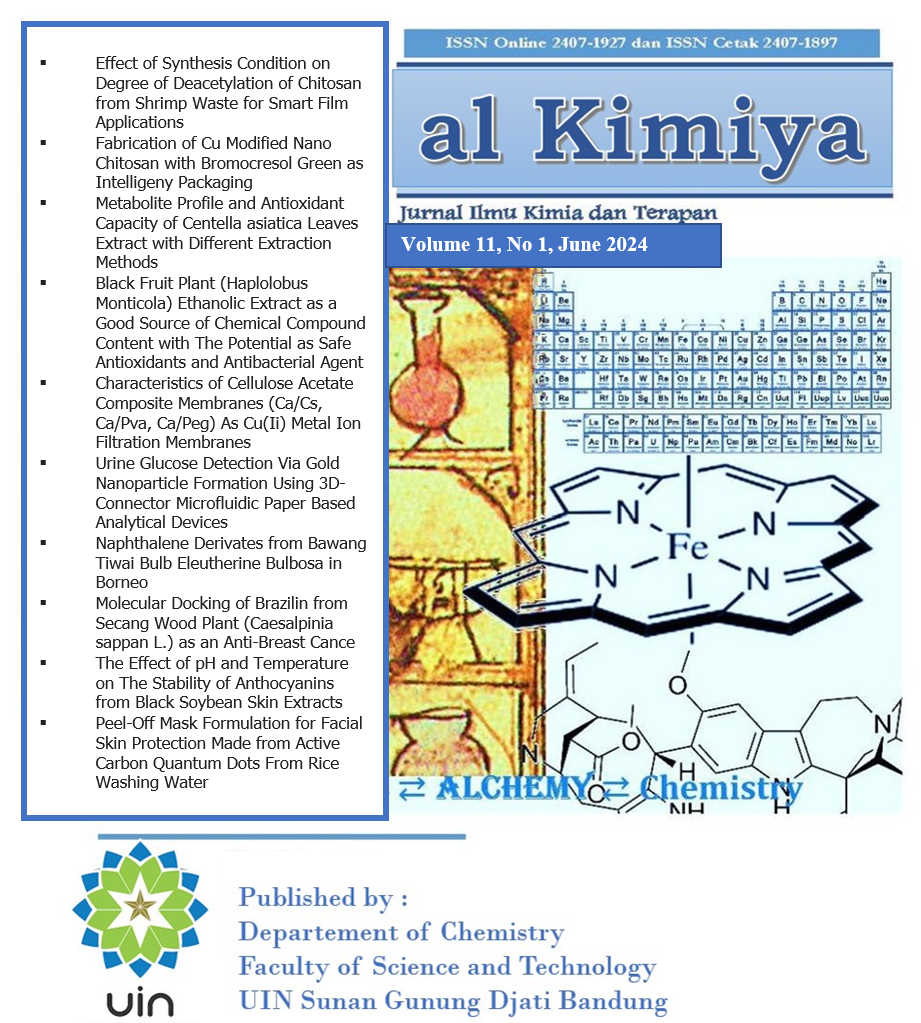Effect of Synthesis Condition on Degree of Deacetylation of Chitosan from Shrimp Waste for Smart Film Applications
DOI:
https://doi.org/10.15575/ak.v11i1.30933Keywords:
chitin, chitosan, autolysis, degree of deacetylation, smart packagingAbstract
References
P. T. Hardani, D. Perwito, and N. A. Mayzika, “Isolasi Kitin dan Kitosan Dari Berbagai Sumber Bahan Alam,†Pros. Semin. Nas. Has. Ris. dan Pengabdi., 3, 469–475, 2021.
E. J. Dompeipen, M. Kaimudin, and R. P. Dewa, “Isolasi Kitin Dan Kitosan Dari Limbah Kulit Udang,†Maj. BIAM, 12 (1), pp. 32–38, 2016, [Online]. Available: http://ejournal.kemenperin.go.id/bpbiam/article/view/2326
C. D. H. Pratiwi, B. Busroni, and A. Sjaifullah, "Modifikasi Kitin Hasil Isolasi Autolisis Dari Limbah Udang Putih (Litopenaeus vannamei) Dengan Anhidrida Maleat," Berk. Sainstek, 8(2), 46, 2020,
https://doi.org/10.19184/bst.v8i2.14223
A. Sjaifullah and A. B. Santoso, "Autolytic Isolation of Chitin from White Shrimp (Penaues Vannamei) Waste," Procedia Chem., 18, Mcls 2015, 49-52, 2016,
https://doi.org/10.1016/j.proche.2016.01.009
T. Yuniarti, A. Prayudi, L. Supenti, H. Suhrawardan, and P. Martosuyono, "Produksi dan Profil Kimia Hidrolisat Protein dari Hasil Samping Pengolahan Udang Segar," J. Perikan., 5066, 2021,
https://doi.org/10.22146/jfs.59906
S. Kumari and R. Kishor, "Chitin and chitosan: origin, properties, and applications," Handb. Chitin Chitosan, 1 Prep. Prop., no. November 2003, 1-33, 2020,
https://doi.org/10.1016/B978-0-12-817970-3.00001-8
A. Purwanti, E. Sulistyaningsih, K. Alika, S. Indradi, C. Saraswaty, and P. Bunganaen, “Pembuatan Kitosan dari Kulit Udang dengan Ekstraksi Menggunakan Microwave,†Teknol. Ind. dan Inf., 2021, no. November, pp. 29–034, 2021, [Online]. Available: http://journal.itny.ac.id/index.php/ReTII
M. Hakam, F. Praditama, and E. Kurniati, "Peningkatan Derajat Deasetilasi dalam Sintesis Kitosan dari Cangkang Kerah Darah," J. Tek. Kim., 17(2), 97-104, 2023,
https://doi.org/10.33005/jurnal_tekkim.v17i2.3789
A. D. R. Madjid, M. Nitsae, and A. Sabarudin, "Perbandingan Butiran Kitosan dengan Pengikat Silang Epiklorohidrin (ECH) dan Glutaraldehid (GLA): Karakterisasi dan Kemampuan Adsorpsi Timbal (Pb)," Alchemy, 6(1), 29, 2018,
https://doi.org/10.18860/al.v6i1.6790
P. Coniwanti, L. Laila, and M. R. Alfira, “Pembuatan Film Plastik Biodegredabel Dari Pati Jagung Dengan Penambahan Kitosan Dan Pemplastis Gliserol,†J. Tek. Kim., 20(4), 22–30, 2014.
E. D. Roida and N. P. Putri, "Aplikasi Polianilin Sebagai Bahan Aktif Pendeteksi Alkohol," Inov. Fis. Indones., 9(2), 152-162, 2020,
https://doi.org/10.26740/ifi.v9n2.p152-162
B. R. Pasela et al., "Synthesis and characterization of acetic acid-doped polyaniline and polyaniline-chitosan composite," Biomimetics, 4(1), 2019,
https://doi.org/10.3390/biomimetics4010015
S. U. Rahman, S. Bilal, and A. U. H. Ali Shah, "Synthesis and characterization of polyaniline-chitosan patches with enhanced stability in physiological conditions," Polymers (Basel)., 12(12), 1-13, 2020,
https://doi.org/10.3390/polym12122870
B. Mohammadi, S. Pirsa, and M. Alizadeh, "Preparing chitosan-polyaniline nanocomposite film and examining its mechanical, electrical, and antimicrobial properties," Polym. Polym. Compos., 27(8), 507-517, 2019,
https://doi.org/10.1177/0967391119851439
S. Wahyuni, R. Selvina, R. Fauziyah, and H. T. Prakoso, "Optimasi Suhu dan Waktu Deasetilasi Kitin Berbasis Selongsong Maggot (Hermetia ilucens) Menjadi Kitosan (Optimization of Temperature and Time of Chitin Deacetylation in Maggot Cells (Hermetia ilucens) to Produce Chitosan)," 25(3), 373-381, 2020,
https://doi.org/10.18343/jipi.25.3.373
D. Silvia et al., “Label Cerdas Berbasis Ekstrak Kubis Merah ( Brassica oleracea ) sebagai Indikator Kesegaran Filet Ikan Tuna ( Thunnus sp ) pada Suhu 4 o C,†10(2), 86–94, 2021.
A. A. I. A. M. Laksmiwati, H. H. Prastika, K. Ratnayani, and N. M. Puspawati, “Penggunaan Enzim Pepsin untuk Produksi Hidrolisat Protein Kacang Gude (Cajanus cajan (L.) Millsp.) yang Aktif Antioksidan,†Indones. E-Journal Appl. Chem., 7(2), 180–188, 2019.
A. M. Silalahi, A. Fadholah, and L. O. Artanti, "Isolasi dan Identifikasi Kitin dan Kitosan dari Cangkang Susuh Kura (Sulcospira testudinaria)," Pharm. J. Islam. Pharm., 4(1), 1-9, 2020,
https://doi.org/10.21111/pharmasipha.v4i1.4963
Agustina et al, “Isolasi Kitin, Karakterisasi, dan Sintesis Kitosan Dari Kulit Udang,†J. Kim., 9(2), 271–278, 2015.
D. Setijawati et al., “Pengaruh Derajad Deasetilasi Chitosan dengan Perlakuan Alkali Berbeda Terhadap Kualitas Edible Film,†JFMR-Journal Fish. Mar. Res., 5(2), 2021, https://doi.org/10.21776/ub.jfmr.2021.005.02.13
B. Setha, B.; Rumata, F.; Sillaban, “Karakteristik Kitosan Dari Kulit Udang Vaname Dengan Menggunakan Suhu dan Waktu Yang Berbeda dalam Proses Deasetilasi,†J. Pengolah. Has. Perikan. Indones., 22(3), 498–507, 2019.
A. Fadli, D. Drastinawati, O. Alexander, and F. Huda, "Pengaruh Rasio Massa Kitin/NaOH Dan Waktu Reaksi Terhadap Karakteristik Kitosan Yang Disintesis Dari Limbah Industri Udang Kering," J. Sains Mater. Indones., 18(2), 61, 2018,
https://doi.org/10.17146/jsmi.2017.18.2.4166
I. Sofia, H. Murdiningsih, and N. Yanti, “Pembuatan Dan Kajian Sifat-Sifat Fisikokimia, Mekanikal, Dan Fungsional Edible Film Dari Kitosan Udang Windu,†J. Bahan Alam Terbarukan, 5(2), 54–60, 2017, https://doi.org/10.15294/jbat.v5i2.6364
Cengristitama and S. Ramlan, “Pengaruh penambahan plasticizer gliserol dan kitosan terhadap karakteristik plastik biogradable berbahan dasar pati sukun,†Tedc, 16(2), 102–108, 2022.
E. Agustiani, M. B. Malino, and B. P. Lapanporo, “Analisis Spektrum Serapan Optis Polianilin Hasil Sintesis Polimerisasi Kimia Interfasial,†Prism. Fis., 1, 1–5, 2013.
Downloads
Published
How to Cite
Issue
Section
Citation Check
License
Authors who publish with this journal agree to the following terms:
- Authors retain copyright and grant the journal right of first publication with the work simultaneously licensed under a Creative Commons Attribution 4.0 International License that allows others to share the work with an acknowledgment of the work's authorship and initial publication in this journal.
- Authors are able to enter into separate, additional contractual arrangements for the non-exclusive distribution of the journal's published version of the work (e.g., post it to an institutional repository or publish it in a book), with an acknowledgment of its initial publication in this journal.
- Authors are permitted and encouraged to post their work online (e.g., in institutional repositories or on their website) prior to and during the submission process, as it can lead to productive exchanges, as well as earlier and greater citation of published work (See The Effect of Open Access).






